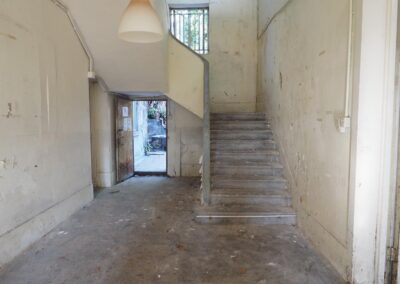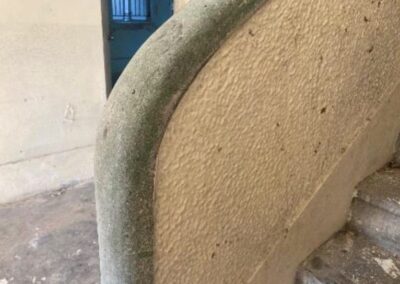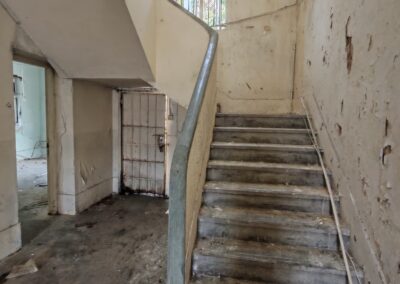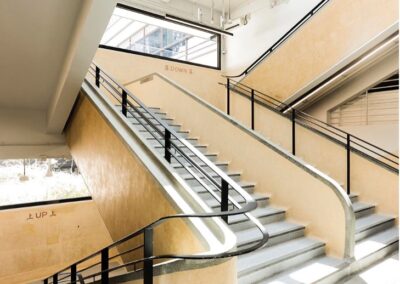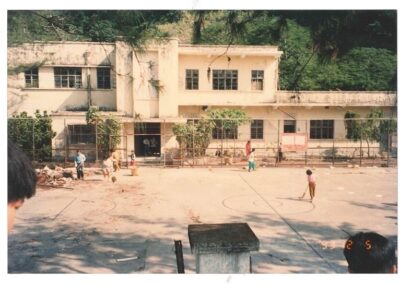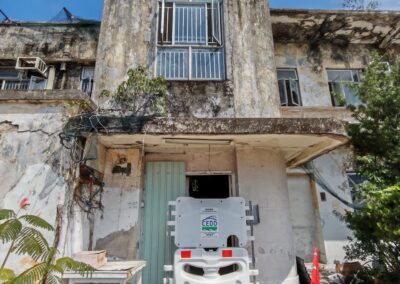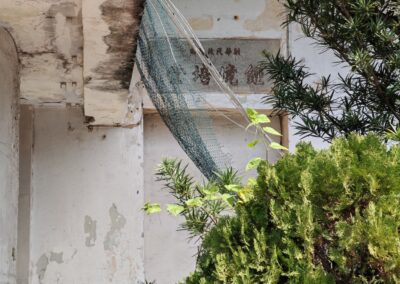
Architect: Hin Lung Li, 1952
Cha Kwo Ling Village School in Peril: Ungraded Historic Building Faces Demolition
(24 February 2025, Hong Kong) In the 2019 Policy Address, the HKSAR government proposed to rebuild three historic villages in the city: Cha Kwo Ling Village, Ngau Chi Wan Village and Chuk Yuen Village. The major public housing development project of the historic Cha Kwo Ling Village started in July 2023, and the demolition of the Village will be completed in 2025. At present, the government only plans to preserve Tin Hau Temple and Law Mansion within Cha Kwo Ling Village, which are both Grade 3 historic buildings. In fact, there is a school next to Tin Hau Temple that is built in the Streamline Moderne style, and its history is inherently related to Cha Kwo Ling and the Temple. This was the Sze Shan Public School,[1] which was founded in 1952 as the only government-aided primary school in Cha Kwo Ling. It was closed in 1993 due to insufficient student enrolment. Sze Shan Public School was formerly known as Sze Shan Free School and was originally located on the site of the former Tin Hau Temple.
A Streamline Moderne building, constructed by a collaborative effort between the government, merchants and local residents
Originally, Sze Shan Free School together with Tin Hau Temple were located at Sai Cho Wan in Kwun Tong (now the area of Laguna City). In 1946, the Asiatic Petroleum Company was planned to be built on the site but were met with resistance as local residents were afraid that the new project would affect the feng shui of Tin Hau Temple. Ronald Ruskin Todd (1902-1980), then Secretary for Chinese Affairs, jointly negotiated with the residents and, in responding to their requests, relocated the Tin Hau Temple to its current location in Cha Kwo Ling in 1948. Sze Shan Free School was also rebuilt next to the New Tin Hau Temple in 1952 and renamed Sze Shan Public School. The cost of rebuilding the Tin Hau Temple was funded by the government, while the funds for building the school were donated by individuals of the local Chinese elite. Until now, the words “Asiatic Company Hall”, “Chinese Temples Committee Hall” and “Chung King Pui Hall” (then Deputy Secretary for Chinese Affairs) are still imprinted above several classroom doors. Sze Shan Public School thus bears witness to the congenial interaction and negotiation between the government, merchants, Chinese elites and local residents in 1950s Hong Kong. It also witnesses a forgotten period of history in which Hong Kong’s village schools were in par with international education principles and modern architectural styles.
Sze Shan Public School is two storeys high, with curvilinear features on the façade of the central entrance block and cantilevered sun-shading fins on each floor emphasizing the horizontality of the building. Internally, the main staircase is beautifully crafted with a curved profile, and the banister decorated with light green terrazzo. The building was designed by Mr. Li Hin-lung (1910-2007, FRIBA, HKIA member in 1956)[2]. Li was reportedly the first Chinese to become a fellow of the Royal Institute of British Architects (FRIBA) [3], and was even appointed as a Member of the Order of the British Empire (M.B.E.). He was architect to the Chinese Temple Committee from 1938 to 1959, and among the Board of Directors in Tung Wah Group of Hospitals in 1952 to 53. In the 30th year commemoration booklet of Sze Shan Public School, he was also listed as one of the individuals who had contributed to the construction of the school. He was undoubtedly a figure of the Chinese elite in early twentieth century Hong Kong, and further research is worth conducting as there is only limited information about him.
Sharing Character-Defining Elements with Central Market
Similar examples such as Sze Shan Public School in Hong Kong are rare, but one such reference can be found in the recently revitalized Central Market (built 1938). The central staircase, similarly with a curved profile and a smooth green terrazzo finish on the banister, is considered one of the major character-defining elements and has been preserved as a popular photographic hotspot today. Together with Wanchai Market (built 1937), these buildings are probably the only few surviving Streamline Moderne architecture in Hong Kong– a style in fact belonging to the late Art Deco period. Nonetheless, together with Sze Shan Public School, these buildings are a testament to the city responding to international currents in modern design in the twentieth century.
Historic buildings can promote “Tourism is everywhere in Hong Kong”
Sze Shan Public School is therefore of integral significance to the history of Cha Kwo Leng and of crucial importance to be preserved together with Tin Hau Temple. Recently, however, several architects and academics within Docomomo Hong Kong[4] noticed that hoarding has already been erected on the top of the school and in preparation for the building to be demolished. Till this day, it is shocking that the 73-year old historic building is not even graded, even with its local and international significance. In raising awareness of the case of Sze Shan Public School, it is anticipated that a more comprehensive grading system within individual districts should be implemented. With the HKSAR Government making recent statements to proactively develop tourism projects with local characteristics to pursue the strategy of “tourism is everywhere in Hong Kong”,[5] it is unfathomable and deeply saddening that such local cultural architectural gems are faced with imminent threats of silent demolition. Therefore, we hope that relevant government departments can reconsider the historical and social value of Cha Kwo Ling Sze Shan Public School and retain such an important landmark within the Greater Bay Area that contains intrinsic educational and cultural heritage of a Hakka village.
[1] ‘Sze Shan’ literally means ‘Four Hills’, and denotes Cha Kwo Ling, Lei Yue Mun, Sai Cho Wan and Ngau Tau Kok.
[2] Tony Lam, “From British Colonization to Japanese Invasion: The 100 Years of Architects in Hong Kong 1841–1941,” HKIA Journal: The Official Journal of the Hong Kong Institute of Architects 45 (2006): 44–55.
[3] “Architect Honoured”. Hong Kong and South China Builder, February 1965.
[4] Docomomo is a non-profit organization and stands for the “Documentation and Conservation of the Modern Movement”.
[5] HKSAR Government Press Release. “LCQ6: Developing tourism projects with local characteristics,” June 12, 2024. https://www.info.gov.hk/gia/general/202406/12/P2024061200433.htm.
Photo of Li Hin Lung (bottom second from right), printed in the 30th anniversary commemorative booklet of Sze Shan Public School. (source: Sze Shan Public School, Sze Shan Public School 30th Anniversary Commemorative Issue 1952-1982 (Hong Kong: Sze Shan Public School, 1982), 37.)
The half-round or ‘bullnose step’ at the bottom of the main staircase, adorned with curved lines on the tread
Grand staircase at Central Market is of a Streamline Moderne design (source: Discover Hong Kong. “Central Market | Hong Kong Tourism Board”, n.d., https://www.discoverhongkong.com/eng/place-to-go/central-market.html)
Old photograph of Sze Shan Public School in 1993 (source: The Conservancy Association Centre for Heritage, Travelling through Cha Kwo Ling – A Memoir of the Urban Village (Hong Kong: The Conservancy Association Centre for Heritage, 2022), 217.)
Sze Shan Public School current state, photo taken on 24 February 2025. (Photo courtesy of Cheng, K.C.)

